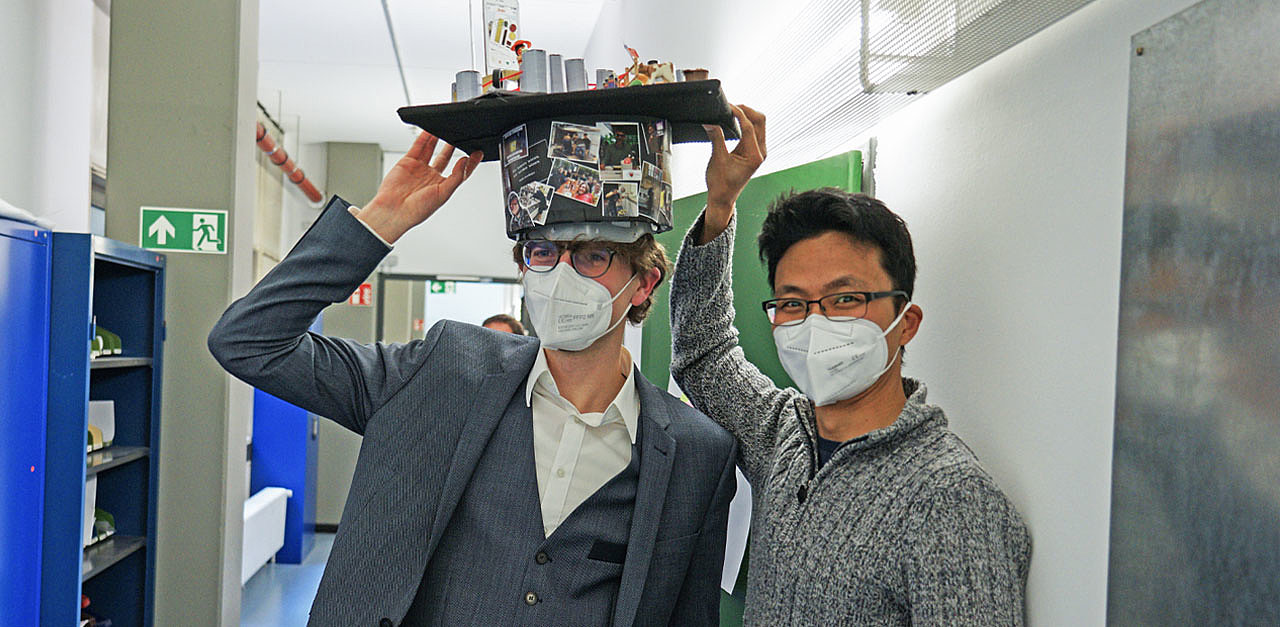Markus Pötzlberger has defended his doctoral thesis titled: "High-power Femtosecond Laser Sources for Mid-Infrared Generation". We congratulate warmly on passing successfully the exam.
Markus‘ challenge was to obtain high peak and average powers from these lasers to generate meaningful amounts of mid-IR light. He combinded for the very first time, an active multipass cell with a Kerr-lens mode-locked (KLM) thin-disk oscillator. The successful union of these two concepts enabled a doubling of the output coupling rate of an oscillator based on ytterbium-doped yttrium aluminum garnet (Yb:YAG) and lasing at a wavelength of 1.03 μm. The resulting oscillator, with an emitted peak power of 40 MW, is the most powerful to date in terms of peak power in ambient air. This successful integration of the active multipass cell opens a new path to more powerful KLM thin-disk oscillators. Besides higher peak powers, a more efficient conversion into the mid-IR can also be achieved by employing longer driving wavelengths. Therefore, a femtosecond KLM thin-disk oscillator operating at a wavelength of 2.1 μm, which uses holmium-doped yttrium aluminum garnet (Ho:YAG) as the gain medium, was developed. Effort in optimizing such oscillators led to a much better understanding of the thin-disk parameter range for optimal laser operation, which is valuable for the future development of more powerful 2.1 μm thin-disk oscillators. Bulk lasers based on chromium-doped zinc sulfide (Cr:ZnS) — a medium with ultrabroadband gain bandwidth — were also identified as a promising driving source. The limited output power of such oscillators required, however, further development of the corresponding amplification systems. Therefore, several approaches, including the first implementation of a Peltier-cooled Cr:ZnS amplifier, were tested. These experiments have shown that a chain of four water-cooled single-pass amplifiers can already boost the femtosecond pulses from an initial average power of 0.73 W to an average power of more than 16 W. Such an amplifier performance shall provide future field-resolved spectroscopy experiments with ample mid-IR power and broader bandwidth. While the Cr:ZnS bulk-laser technology is maturing, the improved Yb:YAG oscillator is already deployed for on-going field-resolved spectroscopy experiments. The further development of the Cr:ZnS technology and of field-resolved spectroscopy shall ultimately lead to the envisioned highly sensitive spectroscopic investigation of important chemical and biological specimens.
Markus‘ challenge was to obtain high peak and average powers from these lasers to generate meaningful amounts of mid-IR light. He combinded for the very first time, an active multipass cell with a Kerr-lens mode-locked (KLM) thin-disk oscillator. The successful union of these two concepts enabled a doubling of the output coupling rate of an oscillator based on ytterbium-doped yttrium aluminum garnet (Yb:YAG) and lasing at a wavelength of 1.03 μm. The resulting oscillator, with an emitted peak power of 40 MW, is the most powerful to date in terms of peak power in ambient air. This successful integration of the active multipass cell opens a new path to more powerful KLM thin-disk oscillators. Besides higher peak powers, a more efficient conversion into the mid-IR can also be achieved by employing longer driving wavelengths. Therefore, a femtosecond KLM thin-disk oscillator operating at a wavelength of 2.1 μm, which uses holmium-doped yttrium aluminum garnet (Ho:YAG) as the gain medium, was developed. Effort in optimizing such oscillators led to a much better understanding of the thin-disk parameter range for optimal laser operation, which is valuable for the future development of more powerful 2.1 μm thin-disk oscillators. Bulk lasers based on chromium-doped zinc sulfide (Cr:ZnS) — a medium with ultrabroadband gain bandwidth — were also identified as a promising driving source. The limited output power of such oscillators required, however, further development of the corresponding amplification systems. Therefore, several approaches, including the first implementation of a Peltier-cooled Cr:ZnS amplifier, were tested. These experiments have shown that a chain of four water-cooled single-pass amplifiers can already boost the femtosecond pulses from an initial average power of 0.73 W to an average power of more than 16 W. Such an amplifier performance shall provide future field-resolved spectroscopy experiments with ample mid-IR power and broader bandwidth. While the Cr:ZnS bulk-laser technology is maturing, the improved Yb:YAG oscillator is already deployed for on-going field-resolved spectroscopy experiments. The further development of the Cr:ZnS technology and of field-resolved spectroscopy shall ultimately lead to the envisioned highly sensitive spectroscopic investigation of important chemical and biological specimens.
